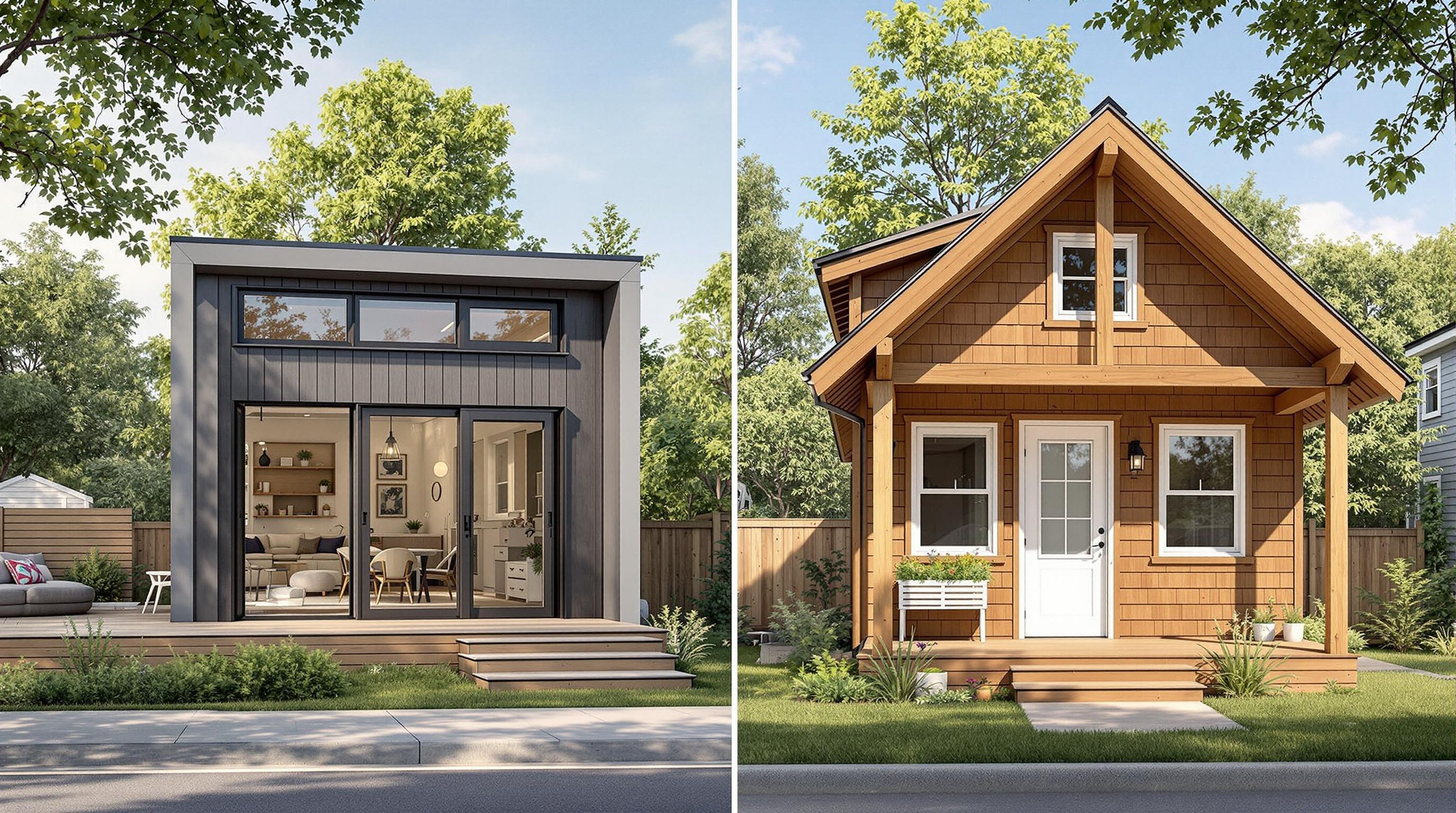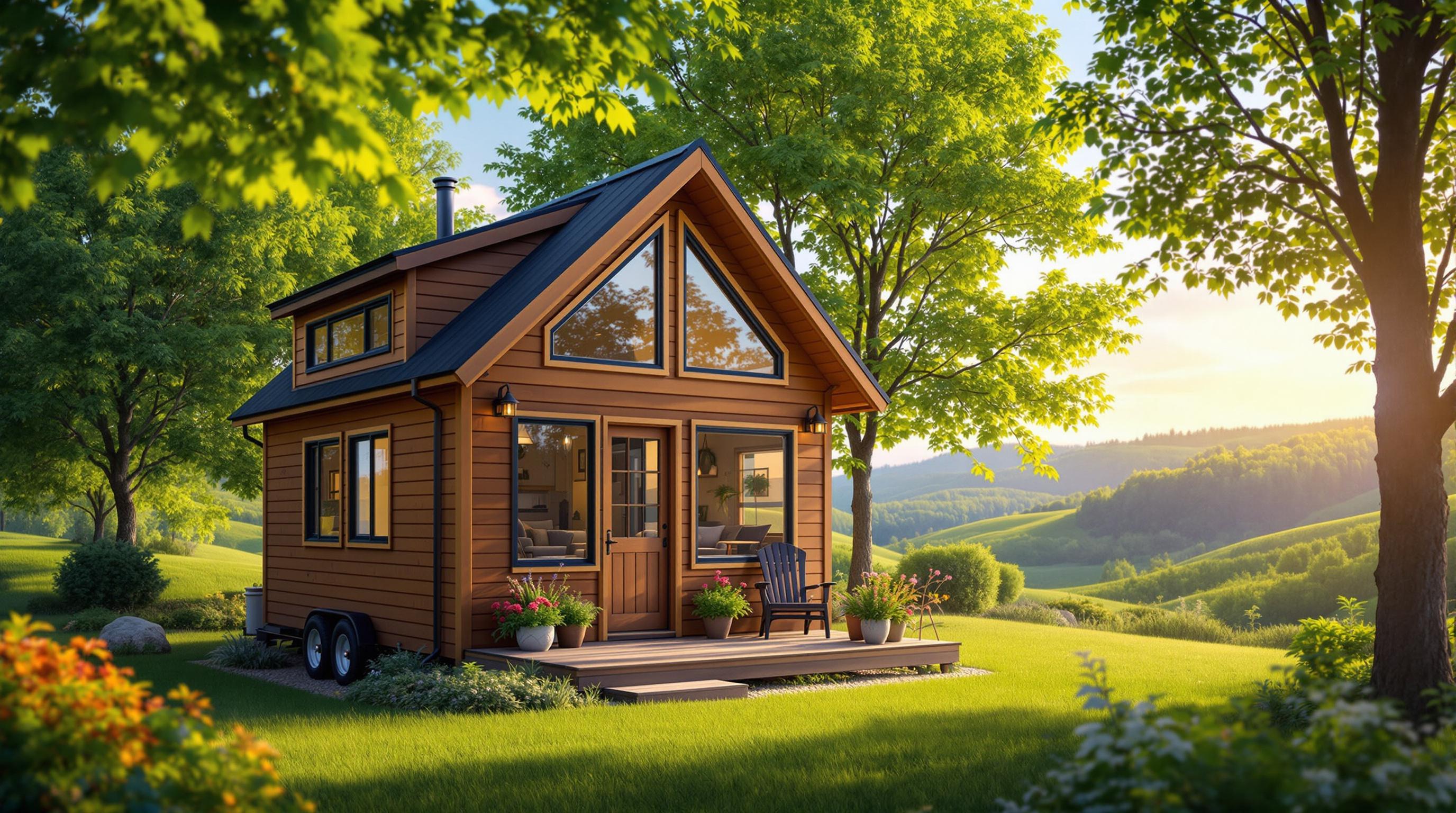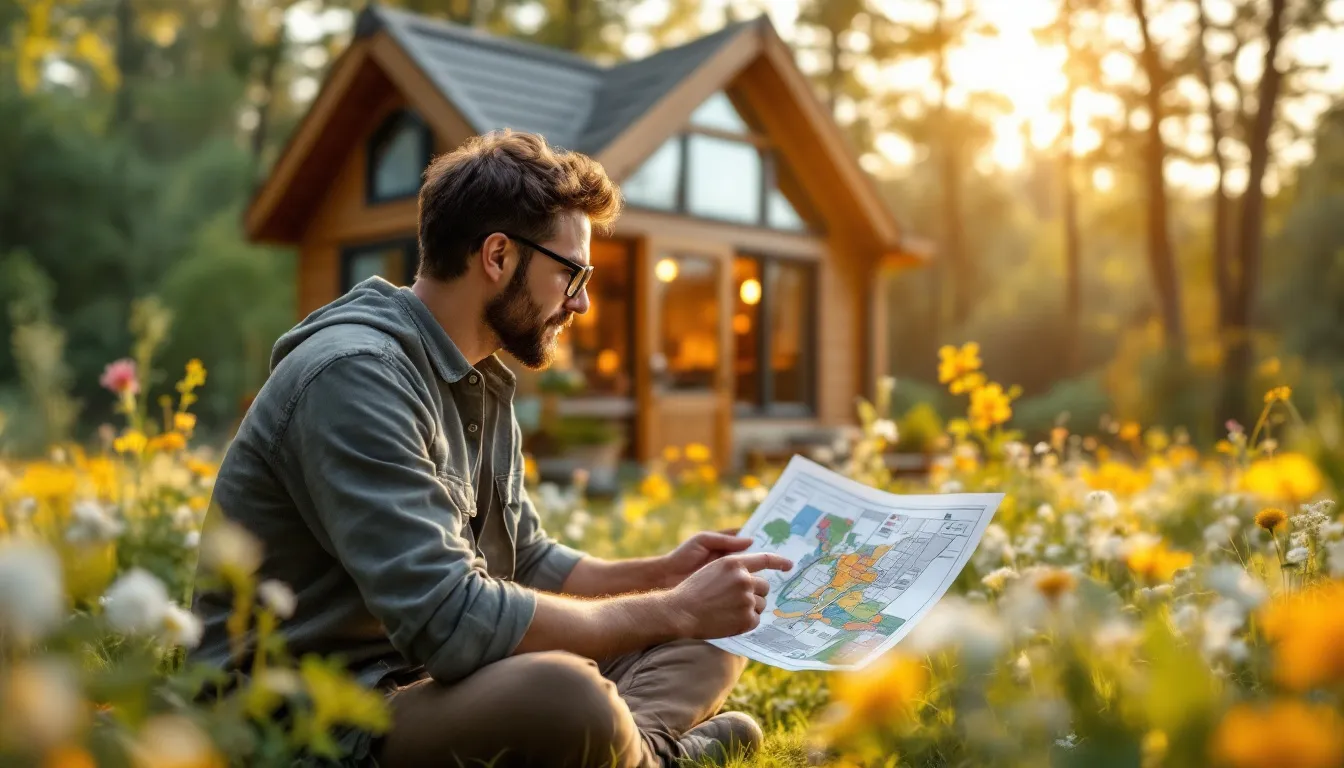Tiny houses are a cost-effective way to enter the real estate market, with prices ranging from $30,000 to $60,000 - far lower than the average home price of $430,000. They appeal to budget-conscious buyers, eco-friendly renters, and investors looking for short-term rental income or long-term community development opportunities.
Key Points:
- Affordability: Lower purchase, building, and maintenance costs compared to traditional homes.
- Profitability: Short-term rentals (Airbnb) and tiny home communities can generate steady income.
- Eco-Friendly Appeal: Energy-efficient designs attract environmentally conscious renters.
- Flexibility: Options range from owning individual units to developing entire communities.
Quick Comparison:
| Feature | Tiny House | Traditional Home |
|---|---|---|
| Purchase Price | $30,000 - $60,000 | $430,000 (avg.) |
| Building Cost | $10,000 - $40,000 | $150,000+ |
| Maintenance Cost | Lower | Higher |
| Utility Bills | Minimal | Substantial |
Pro Tip: Research zoning laws, pick high-demand locations, and collaborate with experienced builders to maximize returns. Tiny houses are an affordable, eco-friendly investment option with growing market demand.
Things to Know Before Investing
Breaking Down the Costs
Investing in a tiny house involves more than just the upfront purchase price, which typically ranges from $30,000 to $60,000 [1][3]. Here’s a closer look at the common expenses you might encounter:
| Expense Category | Typical Cost Range | Notes |
|---|---|---|
| Building Materials | $25,000 - $45,000 | For those opting for DIY construction [3] |
| Land Purchase/Lease | Varies by location | Be mindful of zoning requirements |
| Utility Connections | $5,000 - $10,000 | Covers water, electricity, and sewage |
| Permits & Inspections | $1,000 - $3,000 | Costs depend on local regulations |
| Annual Maintenance | 1-2% of home value | Includes repairs and updates |
These costs can add up quickly, so it’s important to budget carefully and plan for both initial and ongoing expenses.
Options for Financing Tiny Houses
Financing a tiny house is possible through several options. Lenders like LightStream offer financing tailored specifically for tiny homes [3]. Here are some common financing methods:
- Personal Loans: These provide flexibility, with rates based on your credit score.
- Home Equity Loans: Use the equity in your existing property for potentially lower interest rates.
- Builder Financing: Some builders offer in-house financing programs with varying terms.
Each option comes with its own terms, rates, and risks, so it’s important to compare carefully. Once financing is secured, ensure your plans align with local zoning and building laws.
Zoning and Building Rules
Navigating zoning and building regulations is a critical step in tiny house investments. The American Tiny House Association offers helpful resources for understanding these requirements [3]. Ignoring these rules can lead to fines or even jeopardize your investment.
Here are some key points to consider:
- Property Classification: Many areas require tiny houses to be registered as park models or meet specific building codes, which can affect where your house can legally be placed.
- Size Restrictions: Local regulations often specify minimum and maximum square footage, as well as foundation requirements.
- Utility Standards: Even off-grid setups must meet certain standards for water, electricity, and sewage connections.
Before making a purchase, consult your local planning department and, if possible, work with builders experienced in handling your area’s regulations [3][4]. This will help you avoid costly mistakes and ensure your tiny house is compliant.
How to Make Tiny House Investments Work
Picking the Best Location
Selecting the right location is key to making tiny house investments successful. Areas like tourist destinations, college towns, and places with housing shortages often provide the best opportunities [1][4].
Some high-potential spots include:
- Tourist destinations with limited affordable lodging options
- Suburban areas just outside major cities
- College towns where students seek compact, affordable housing
- Areas near parks, lakes, or other outdoor attractions
After identifying a promising location, partnering with skilled builders ensures your project meets quality standards and complies with local regulations.
Working with Experienced Builders
Collaborating with established builders can make a big difference. Companies like Rocky Mountain Tiny Houses (custom designs), Tumbleweed Tiny House Company (eco-conscious builds), and New Frontier Tiny Homes (high-end finishes) bring expertise in construction and local regulations [1]. Their experience helps reduce risks, ensures adherence to zoning laws, and boosts your chances of a solid return on investment.
For those thinking bigger, creating tiny house communities can take your investment strategy to the next level.
Developing Tiny House Communities
Investing in entire tiny house communities can yield even better returns while attracting long-term tenants. Here’s how to make it work:
1. Start with Market Research
Dive into local demographics, housing needs, and competitors. Use this data to shape your community’s amenities and pricing plans.
2. Design Smart Layouts
Incorporate shared spaces like community gardens, outdoor gathering areas, storage facilities, and parking. This setup strikes a balance between privacy and fostering community.
3. Set Up Professional Management
Implement clear rules and hire reliable property managers to maintain the property’s value and secure steady rental income [2][4].
"Upgrading existing mobile home parks with tiny houses has shown significant increases in property value and rental income across markets in California, Georgia, and North Carolina" [1][4].
Tips for First-Time Tiny House Investors
Start Small and Build Experience
When diving into tiny house investments, it's smart to begin with just one project. This lowers your risk while allowing you to learn the ropes. With initial costs typically ranging from $30,000 to $60,000 [1][3], tiny houses are a more budget-friendly way to enter the real estate market compared to traditional properties.
For your first venture, focus on these key steps:
- Check local zoning and building rules: Ensure your project aligns with regulations.
- Plan your budget carefully: Use the cost breakdown section as a guide.
- Develop a long-term approach: Think about marketing, pricing, and upkeep strategies.
Once you’ve gained some experience, you can use online tools to fine-tune your approach and uncover new opportunities.
Leverage Online Tools and Resources
Online platforms can be incredibly helpful for tiny house investors. For instance, TinyHouseListings.com offers tools to:
- Compare prices across different regions
- Research trends in the tiny house market
- Access detailed property listings
- Explore thriving tiny house communities
These platforms also connect you with like-minded investors, making it easier to exchange ideas, learn from others, and discover useful resources.
Get Involved in Tiny House Communities
Joining tiny house communities is a great way to expand your knowledge and network. Engaging with experienced investors can provide valuable tips and insights into the market. Being part of these groups gives you:
- Access to practical advice from seasoned investors
- Early notice of new investment opportunities
- Updates on market trends and forecasts
- Reliable supplier recommendations
Building strong connections within the community can lead to partnerships and opportunities that help you grow your investment portfolio faster.
Additionally, focus on eco-friendly designs to appeal to renters who prioritize sustainability. Features like solar panels or rainwater collection systems not only attract tenants but also help lower costs and boost property value [1][4].
sbb-itb-2ef3f3a
Conclusion: Taking the First Step in Tiny House Investing
Key Takeaways
Investing in tiny houses can be a practical way to enter the real estate market, with upfront costs typically ranging from $30,000 to $60,000 [1][3]. Success hinges on choosing the right location, following regulations, and planning your finances carefully - topics we've covered throughout this guide.
Getting Started with Tiny House Investments
Ready to take action? Here’s how you can turn your plans into reality:
Do Your Homework
- Research market trends and pricing using reliable platforms.
- Build a comprehensive budget that includes:
- Costs for purchasing or building the tiny house
- Land expenses (buying or leasing)
- Fees for permits and legal requirements
- Funds for ongoing maintenance
- Marketing costs to attract tenants or buyers
Analyze the Market
Study rental rates, local demand, competition, and amenities in potential locations. Areas near business hubs or tourist hotspots often show stronger rental opportunities [1][2].
Take Action
Start with these steps:
- Dive deep into your target market to understand its dynamics.
- Secure financing that aligns with your budget and goals.
- Engage with local tiny house communities to gain insights and support.
- Begin with one property to learn the ropes before considering expansion [4].
Are Tiny Homes a Good Investment?
FAQs
Here are answers to some frequently asked questions about investing in tiny homes, offering practical advice for potential investors.
Is investing in a tiny home a good idea?
Tiny homes can be a smart choice for those looking for lower upfront costs and smaller-scale real estate opportunities. Their success often hinges on picking the right location - think tourist hotspots or areas with housing shortages - and appealing to budget-conscious renters or buyers. With starting costs typically ranging from $30,000 to $60,000 [1][3], tiny homes provide a relatively affordable way to enter the real estate market while promoting eco-friendly living.
Are tiny homes a profitable investment?
Tiny homes can generate strong returns if managed wisely. Key factors for profitability include:
- Location matters: Properties near tourist destinations or in areas with limited housing options tend to perform well [1][2].
- Keep costs low: Efficient maintenance and utility management can boost margins [5].
- Maximize income: Short-term rentals often bring in more revenue than long-term leases [1][4].
- Explore options: Developing tiny home communities with shared amenities or flipping properties with upgrades can also be lucrative.
To succeed, it's crucial to understand local regulations, work with experienced builders, and maintain solid financial oversight [1][4]. For beginners, pre-owned tiny homes priced under $50,000 can offer a more affordable starting point [3].
What mistakes should first-time investors avoid?
New investors should steer clear of these common errors:
- Ignoring local zoning laws and building codes
- Underestimating total costs, including land, utilities, and upkeep
- Picking locations without researching demand
- Failing to account for seasonal changes in rental income
- Skipping advice from experienced builders or community members
"Tiny home investments require you to do your homework, research your land restrictions, and get to know the community, with the end goal being to make money and have fun" [2].



